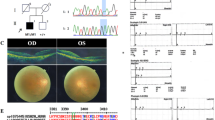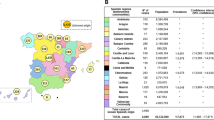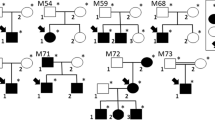Abstract
Hereditary retinal dystrophies (RD) constitute a group of blinding diseases that are characterized by clinical variability and pronounced genetic heterogeneity. The different forms of RD can be caused by mutations in >100 genes, including >1600 exons. Consequently, next generation sequencing (NGS) technologies are among the most promising approaches to identify mutations in RD. So far, NGS is not routinely used in gene diagnostics. We developed a diagnostic NGS pipeline to identify mutations in 170 genetically and clinically unselected RD patients. NGS was applied to 105 RD-associated genes. Underrepresented regions were examined by Sanger sequencing. The NGS approach was successfully established using cases with known sequence alterations. Depending on the initial clinical diagnosis, we identified likely causative mutations in 55% of retinitis pigmentosa and 80% of Bardet–Biedl or Usher syndrome cases. Seventy-one novel mutations in 40 genes were newly associated with RD. The genes USH2A, EYS, ABCA4, and RHO were more frequently affected than others. Occasionally, cases carried mutations in more than one RD-associated gene. In addition, we found possible dominant de-novo mutations in cases with sporadic RD, which implies consequences for counseling of patients and families. NGS-based mutation analyses are reliable and cost-efficient approaches in gene diagnostics of genetically heterogeneous diseases like RD.
Similar content being viewed by others
Log in or create a free account to read this content
Gain free access to this article, as well as selected content from this journal and more on nature.com
or
References
Berger W, Kloeckener-Gruissem B, Neidhardt J : The molecular basis of human retinal and vitreoretinal diseases. Prog Retin Eye Res 2010; 29: 335–375.
Hartong DT, Berson EL, Dryja TP : Retinitis pigmentosa. Lancet 2006; 368: 1795–1809.
Avila-Fernandez A, Cantalapiedra D, Aller E et al: Mutation analysis of 272 Spanish families affected by autosomal recessive retinitis pigmentosa using a genotyping microarray. Mol Vis 2010; 16: 2550–2558.
Zeitz C, Labs S, Lorenz B et al: Genotyping microarray for CSNB-associated genes. Invest Ophthalmol Vis Sci 2009; 50: 5919–5926.
Zernant J, Kulm M, Dharmaraj S et al: Genotyping microarray (disease chip) for Leber congenital amaurosis: detection of modifier alleles. Invest Ophthalmol Vis Sci 2005; 46: 3052–3059.
Jaakson K, Zernant J, Kulm M et al: Genotyping microarray (gene chip) for the ABCR (ABCA4) gene. Hum Mutat 2003; 22: 395–403.
Gonzalez-del PM, Borrego S, Barragan I et al: Mutation screening of multiple genes in Spanish patients with autosomal recessive retinitis pigmentosa by targeted resequencing. PLoS One 2011; 6: e27894.
Clark GR, Crowe P, Muszynska D et al: Development of a diagnostic genetic test for simplex and autosomal recessive retinitis pigmentosa. Ophthalmology 2010; 117: 2169–2177.
Daiger SP, Sullivan LS, Bowne SJ et al: Targeted high-throughput DNA sequencing for gene discovery in retinitis pigmentosa. Adv Exp Med Biol 2010; 664: 325–331.
Audo I, Bujakowska KM, Leveillard T et al: Development and application of a next-generation-sequencing (NGS) approach to detect known and novel gene defects underlying retinal diseases. Orphanet J Rare Dis 2012; 7: 8.
Neveling K, Collin RW, Gilissen C et al: Next-generation genetic testing for retinitis pigmentosa. Hum Mutat 2012; 33: 963–972.
O'Sullivan J, Mullaney BG, Bhaskar SS et al: A paradigm shift in the delivery of services for diagnosis of inherited retinal disease. J Med Genet 2012; 49: 322–326.
Simpson DA, Clark GR, Alexander S, Silvestri G, Willoughby CE : Molecular diagnosis for heterogeneous genetic diseases with targeted high-throughput DNA sequencing applied to retinitis pigmentosa. J Med Genet 2011; 48: 145–151.
Grant JR, Arantes AS, Liao X, Stothard P : In-depth annotation of SNPs arising from resequencing projects using NGS-SNP. Bioinformatics 2011; 27: 2300–2301.
Lewis RA, Shroyer NF, Singh N et al: Genotype/phenotype analysis of a photoreceptor-specific ATP-binding cassette transporter gene, ABCR, in Stargardt disease. Am J Hum Genet 1999; 64: 422–434.
Morimura H, Fishman GA, Grover SA, Fulton AB, Berson EL, Dryja TP : Mutations in the RPE65 gene in patients with autosomal recessive retinitis pigmentosa or leber congenital amaurosis. Proc Natl Acad Sci USA 1998; 95: 3088–3093.
Shanks ME, Downes SM, Copley RR et al: Next-generation sequencing (NGS) as a diagnostic tool for retinal degeneration reveals a much higher detection rate in early-onset disease. Eur J Hum Genet 2012; 21: 274–280.
Benaglio P, Rivolta C : Ultra high throughput sequencing in human DNA variation detection: a comparative study on the NDUFA3-PRPF31 region. PLoS One 2010; 5: 9.
Vissers LE, de LJ, Gilissen C et al: A de novo paradigm for mental retardation. Nat Genet 2010; 42: 1109–1112.
Benaglio P, McGee TL, Capelli LP, Harper S, Berson EL, Rivolta C : Next generation sequencing of pooled samples reveals new SNRNP200 mutations associated with retinitis pigmentosa. Hum Mutat 2011; 32: E2246–E2258.
Zhao C, Bellur DL, Lu S et al: Autosomal-dominant retinitis pigmentosa caused by a mutation in SNRNP200, a gene required for unwinding of U4/U6 snRNAs. Am J Hum Genet 2009; 85: 617–627.
Rivolta C, McGee TL, Rio FT, Jensen RV, Berson EL, Dryja TP : Variation in retinitis pigmentosa-11 (PRPF31 or RP11) gene expression between symptomatic and asymptomatic patients with dominant RP11 mutations. Hum Mutat 2006; 27: 644–653.
Zhang Q, Zulfiqar F, Xiao X et al: Severe retinitis pigmentosa mapped to 4p15 and associated with a novel mutation in the PROM1 gene. Hum Genet 2007; 122: 293–299.
Permanyer J, Navarro R, Friedman J et al: Autosomal recessive retinitis pigmentosa with early macular affectation caused by premature truncation in PROM1. Invest Ophthalmol Vis Sci 2010; 51: 2656–2663.
Michaelides M, Gaillard MC, Escher P et al: The PROM1 mutation p.R373C causes an autosomal dominant bull's eye maculopathy associated with rod, rod-cone, and macular dystrophy. Invest Ophthalmol Vis Sci 2010; 51: 4771–4780.
Yang Z, Chen Y, Lillo C et al: Mutant prominin 1 found in patients with macular degeneration disrupts photoreceptor disk morphogenesis in mice. J Clin Invest 2008; 118: 2908–2916.
den Hollander AI, Koenekoop RK, Yzer S et al: Mutations in the CEP290 (NPHP6) gene are a frequent cause of Leber congenital amaurosis. Am J Hum Genet 2006; 79: 556–561.
Poloschek CM, Bach M, Lagreze WA et al: ABCA4 and ROM1: implications for modification of the PRPH2-associated macular dystrophy phenotype. Invest Ophthalmol Vis Sci 2010; 51: 4253–4265.
Acknowledgements
We would like to thank all patients for participating in this study. We are grateful for technical assistance from Esther Glaus and Mariana Wittmer. We thank Detlef Boehm for his help in setting up the first versions of the panel. He was employed by CeGaT during that time. This work was in part supported by a grant of the BMBF (01GM1108A to BW and SK) and the Forschungskredit of the University of Zurich (to JN).
Author information
Authors and Affiliations
Corresponding author
Ethics declarations
Competing interests
The authors declare no conflict of interest.
Additional information
Supplementary Information accompanies this paper on European Journal of Human Genetics website
Supplementary information
Rights and permissions
About this article
Cite this article
Glöckle, N., Kohl, S., Mohr, J. et al. Panel-based next generation sequencing as a reliable and efficient technique to detect mutations in unselected patients with retinal dystrophies. Eur J Hum Genet 22, 99–104 (2014). https://doi.org/10.1038/ejhg.2013.72
Received:
Revised:
Accepted:
Published:
Issue date:
DOI: https://doi.org/10.1038/ejhg.2013.72
Keywords
This article is cited by
-
Unearthing FLVCR1a: tracing the path to a vital cellular transporter
Cellular and Molecular Life Sciences (2024)
-
A novel homozygous missense substitution p.Thr313Ile in the PDE6B gene underlies autosomal recessive retinitis pigmentosa in a consanguineous Pakistani family
BMC Ophthalmology (2023)
-
Genetic tool used to diagnose achromatopsia: first case report from India
Egyptian Journal of Medical Human Genetics (2023)
-
No strong evidence to date for an association between RIMS1 and retinal dystrophy
Documenta Ophthalmologica (2023)
-
Autosomal dominant optic atrophy caused by six novel pathogenic OPA1 variants and genotype–phenotype correlation analysis
BMC Ophthalmology (2022)



